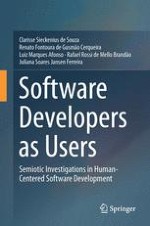This book presents the SigniFYI Suite of conceptual and methodological tools, designed to uncover meanings inscribed in software, their origins, intent and consequences to identify and trace correlating patterns; from software design and development to software use and experience.
Based on the study of Semiotic Engineering, the book advances the e study of Human-Centered Computing (HCC), inviting professionals, researchers, teachers and students to reflect upon how subjective and cultural values manifest themselves through software models, programs and user interfaces.
The authors weave a mesh of technical, theoretical and philosophical considerations of what it means to build and use software, exploring what we (professionals and non-professionals) mean by the pieces of software we design and develop, as well as what pieces of software mean to end-users and others.
Explicitly dedicated to software designers, developers and users, Software Developers as Users is a provocative view of socio-technical communication in the digital age.
